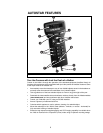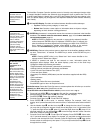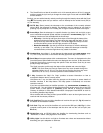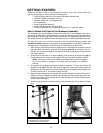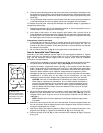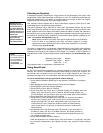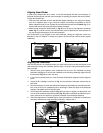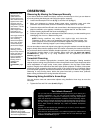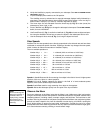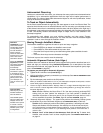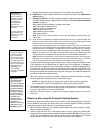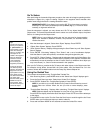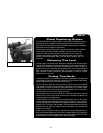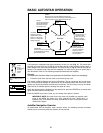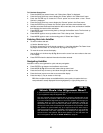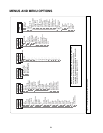
17
2.
Verify that AutoStar is properly connected to your telescope. See
HOW
TO ASSEMBLE YOUR
TELESCOPE,
page 13.
3. Flip the telescope power switch to the ON position.
The AutoStar screen is activated and a copyright message displays briefly, followed by a
short beep.Then AutoStar takes a few moments to start up the system.
“Press 0 to align or
Mode for Menu” displays (if you select "0" automatic Alignment will begin).
4.
The Arrow keys are now activated. Press the Arrow keys (
5,
Fig. 2
) to sle
w (move) the
telescope up, down, right, or left.
5. Press a Number key (8, Fig. 2) to change the telescope’s slew speed. See SLEW SPEEDS,
below, for more information.
6. Use SmartFinder (
17, Fig.1) and/or the viewfinder (1, Fig.20) to locate an object and prac-
tice using the AutoStar’s Arrow keys to center the object in the telescope’s field of view.
7. Use the telescope’s focus knob (8, Fig. 1) to bring the object into focus.
Slew Speeds
AutoStar has nine slew speeds that are directly proportional to the sidereal rate and have been
calculated to accomplish specific functions. Pressing a Number key changes the slew speed,
which is shown for about two seconds on AutoStar’s display.
The nine available speeds are:
Number Key 1 = 1x = 1 x sidereal (0.25 arc-min/sec or 0.004°/sec)
Number Key 2 = 2x = 2 x sidereal (0.5 arc-min/sec or 0.008°/sec)
Number Key 3 = 8x = 8 x sidereal (2 arc-min/sec or 0.033°/sec)
Number Key 4 = 16x = 16 x sidereal (4 arc-min/sec or 0.067°/sec)
Number Key 5 = 64x = 64 x sidereal (16 arc-min/sec or 0.27°/sec)
Number Key 6 = 128x = 32 arc-min/sec or 0.5°/sec
Number Key 7 = 1.5° = 90 arc-min/sec or 1.5°/sec
Number Key 8 = 3° = 180 arc-min/sec or 3°/sec
Number Key 9 = Max = 390 arc-min/sec or 6.5°/sec)
Speeds 1, 2, or 3: Best used for fine centering of an object in the field of view of a higher power
eyepiece, such as a 12mm or a 9mm eyepiece.
Speeds 4, 5, or 6: Enables centering an object in the field of a low-to-moderate power
e
y
epiece
, such as the standard Super Plössl
26mm.
Speeds 7 or 8: Best used for rough centering of an object in the eyepiece.
Speed 9: Mo
v
es the telescope quic
kly from one point in the sky to another
Observe the Moon
Point your telescope at the Moon (note that the Moon is not visible every night) and practice
using the Arrow keys and the slew speeds to view different features. The Moon contains many
interesting features, including craters, mountain ranges, and fault lines. The best time to view
the Moon is during its crescent or half phase.Sunlight strikes the Moon at an angle during these
periods and adds a depth to the view. No shadows are seen during a full Moon, causing the
o
v
er
ly br
ight surf
ace to appear flat and r
ather uninteresting.
Consider the use of a neutral
density Moon filter when observing the Moon.Not only does it cut down the Moon's bright glare,
b
ut it also enhances contrast, providing a more dramatic image.
NOTE:
Do not look through the
telescope's eyepiece or
vie
wfinder while it is
rapidly moving. Children
should always have
adult supervision while
observing.



